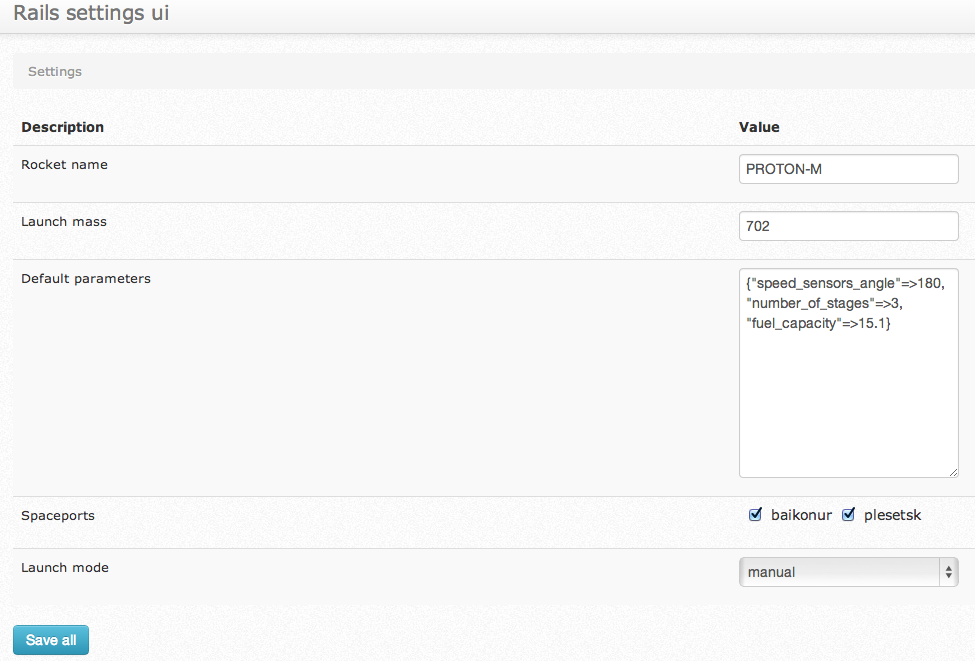README.md
Rails settings UI
================================
[](https://rubygems.org/gems/rails-settings-ui)
[](https://github.com/accessd/rails-settings-cached/actions?query=workflow%3Abuild)
A Rails Engine to manage your application settings. Includes validation. Compatible with Rails 7.
It depends on [rails-settings-cached](https://github.com/huacnlee/rails-settings-cached) gem.
Preview:

How to
-----
Add to Gemfile
gem 'rails-settings-ui'
If you want to use bootstrap interface you need also include bootstrap stylesheets to your app.
You may use [bootstrap-sass](https://github.com/twbs/bootstrap-sass) gem for that.
Setup:
# adds initializer and route:
rails g rails_settings_ui:install
Config
------------
In config/initializers/rails_settings_ui.rb
RailsSettingsUi.setup do |config|
config.ignored_settings = [:company_name] # Settings not displayed in the interface
config.settings_class = "MySettings" # Customize settings class name
config.settings_displayed_as_select_tag = [:mode] # Settings displayed as select tag instead of checkbox group field
config.defaults_for_settings = {mode: :manual} # Default option values for select tags
config.engine_name = "your engine name" # Default use 'main_app', if you mount this engine to another engine, then set name of engine
end
Routing
-------
# engine root:
rails_settings_ui_url
I18n
-------------
You can localize:
* Settings names, eg:
```yaml
settings:
attributes:
launch_mode: # setting name
name: 'Launch mode'
```
* Checkbox options labels for array options, eg:
```yaml
settings:
attributes:
launch_mode:
labels:
auto: 'Auto mode'
manual: 'Manual mode'
```
* Select options labels and values, eg:
```yaml
settings:
attributes:
buy_mode:
labels:
auto: 'Auto buy' # 'auto' is option value, 'Auto buy' is option label
manual: 'Manual buy'
```
so result will be:
```html
<option value="auto">Auto buy</option>
<option value="manual">Manual buy</option>
```
if you don't specify labels in locale config, you'll get:
```html
<option value="auto">auto</option>
<option value="manual">manual</option>
```
* Help blocks for settings, eg:
```yaml
settings:
attributes:
launch_mode:
help_block: 'launch mode'
```
Validations
-------------
Validations work based on default value for setting or by explicitly specify type for setting, eg:
class Settings < RailsSettings::Base
cache_prefix { "v1" }
field :company_name, type: :string, default: "Company name"
field :head_name, default: "Head name"
field :manager_premium, default: 19
field :show_contract_fields, default: true
field :launch_mode, default: [:auto, :manual]
end
Views
-------------
Default layout is `application`, but you can render all rails-settings-ui views inside your app layout
(for nice looking you will need include bootstrap, eg: `@import 'bootstrap';` in your applications.css.scss):
Rails.application.config.to_prepare do
# Use admin layout:
RailsSettingsUi::ApplicationController.module_eval do
layout 'admin'
end
# If you are using a custom layout, you will want to make app routes available to rails-setting-ui:
RailsSettingsUi.inline_engine_routes! # old name of method inline_main_app_routes!
end
Authentication & authorization
------------------------------
You can specify the parent controller for settings controller, and it will inherit all before filters.
Note that this must be placed before any other references to rails-setting-ui application controller in the initializer:
RailsSettingsUi.parent_controller = 'Admin::ApplicationController' # default: '::ApplicationController'
Alternatively, to have custom rules just for rails-setting-ui you can:
Rails.application.config.to_prepare do
RailsSettingsUi::ApplicationController.module_eval do
before_action :check_settings_permissions
private
def check_settings_permissions
render status: 403 unless current_user && can_manage_settings?(current_user)
end
end
end
Issues
-------------
* If you wish to use route helpers for your app in parent controllers of `RailsSettingsUi::ApplicationController`, you must call helpers for `main_app`, for example: `main_app.root_path`
This project uses MIT-LICENSE.